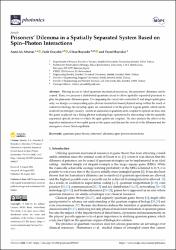Prisoners’ dilemma in a spatially separated system based on spin–photon interactions
Künye
Altıntaş, A. A., Özaydın, F., Bayındır, C. & Bayrakçı, V. (2022). Prisoners’ dilemma in a spatially separated system based on spin–photon interactions. Photonics, 9(9), 1-13. doi:10.3390/photonics9090617Özet
Having access to ideal quantum mechanical resources, the prisoners’ dilemma can be ceased. Here, we propose a distributed quantum circuit to allow spatially separated prisoners to play the prisoners’ dilemma game. Decomposing the circuit into controlled-Z and single-qubit gates only, we design a corresponding spin–photon-interaction-based physical setup within the reach of current technology. In our setup, spins are considered to be the players’ logical qubits, which can be realized via nitrogen-vacancy centers in diamond or quantum dots coupled to optical cavities, and the game is played via a flying photon realizing logic operations by interacting with the spatially separated optical cavities to which the spin qubits are coupled. We also analyze the effect of the imperfect realization of two-qubit gates on the game, and discuss the revival of the dilemma and the emergence of new Nash equilibria.


















